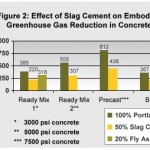 |
| Reviews and Templates for Expression We |
San Francisco 49ers Buy Low-CO2 Concrete for New Stadium
Central Concrete, a US Concrete company, will supply about 80,000 cubic yards of its low-CO2 concrete for the new San Francisco 49ers stadium, the company said.
The mixes selected, which will be used for the auger cast piles and overall stadium structure, use less materials than traditional concrete and will reduce the stadium’s overall carbon footprint by 23 million pounds of CO2, Central Concrete said. The company has supplied low-CO2 concrete for the San Francisco Public Utilities Headquarters, NASA Ames Building, San Francisco Academy of Sciences, San Jose Arena, Stanford Stadium and Santa Clara University Stephen Schott Baseball Stadium.
Typically, creating 1 ton of traditional cement releases 1 ton of CO2 into the atmosphere, Central said. To combat this problem, the company uses what it calls “EF Technologies,” including alternative or supplementary cementitious materials such as fly ash and slag. EF stands for “environmentally friendly.”
Fly ash (also known as a coal combustion product or CCP) is the mineral residue resulting from the combustion of powdered coal in power generating plants. It consists mostly of silicon dioxide, aluminum oxide and iron oxide. It is pozzolanic in nature, meaning it reacts with calcium hydroxide and alkali to form cementitious compounds.
Most power plants are required by law to reduce their fly ash emissions to less than one percent, Central Concrete says. The remaining 99 percent is collected using electrostatic precipitators or filter bags. Initially, power plants disposed of this collected ash in ash ponds or landfills. Once the ash’s pozzolanic properties were discovered, however, some companies began using it as a replacement for Portland cement in concrete.
Portland cement is the glue that binds concrete together. According to Central Concrete, the production of Portland cement accounts for about five percent of human-generated CO2 worldwide, and fly ash can replace up to 50 percent of the Portland cement required to manufacture concrete.
Central Concrete has also been using slag, the by-product of smelting ore to purify metals. Processing blast furnace slag into slag cement or slag aggregate reduces the air emissions at the blast furnace and the material in landfills. Slag also decreases Portland cement usage by as much as 50 percent.
According to Central Concrete, using a 50 percent slag cement substitution saves between 165 and 374 pounds of CO2 per cubic yard of concrete—a 42 to 46 percent reduction in greenhouse gas emissions (see chart). Slag cement requires nearly 90 percent less energy to produce than an equivalent amount of Portland cement, the company says.
In related news, researchers at George Washington University have developed a machine they say uses sunlight to power a chemical process to make lime, a key ingredient in cement, without emitting carbon dioxide, MIT’s Technology Review reports.
|
|
|
|
Copyright 2011 Energy and Technical Services Ltd. All Rights Reserved. Energyts.com |